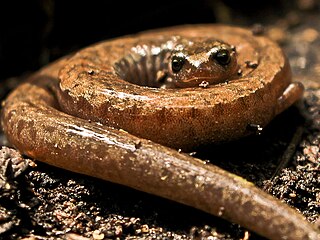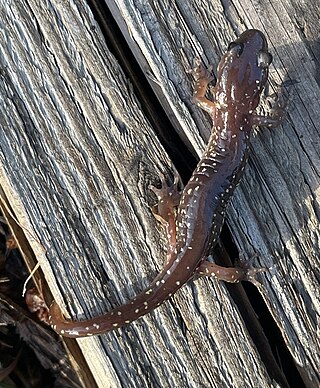
Amphibians are ectothermic, anamniotic, four-limbed vertebrate animals that constitute the class Amphibia. In its broadest sense, it is a paraphyletic group encompassing all tetrapods excluding the amniotes. All extant (living) amphibians belong to the monophyletic subclass Lissamphibia, with three living orders: Anura, Urodela (salamanders), and Gymnophiona (caecilians). Evolved to be mostly semiaquatic, amphibians have adapted to inhabit a wide variety of habitats, with most species living in freshwater, wetland or terrestrial ecosystems. Their life cycle typically starts out as aquatic larvae with gills known as tadpoles, but some species have developed behavioural adaptations to bypass this.

Salamanders are a group of amphibians typically characterized by their lizard-like appearance, with slender bodies, blunt snouts, short limbs projecting at right angles to the body, and the presence of a tail in both larvae and adults. All ten extant salamander families are grouped together under the order Urodela from the group Caudata. Urodela is a scientific Latin term based on the Ancient Greek οὐρά δήλη: ourà dēlē "conspicuous tail". Caudata is the Latin for "tailed ones", from cauda: "tail".

Plethodontidae, or lungless salamanders, are a family of salamanders. With over 500 species, lungless salamanders are by far the largest family of salamanders in terms of their diversity. Most species are native to the Western Hemisphere, from British Columbia to Brazil. Only two extant genera occur in the Eastern Hemisphere: Speleomantes and Karsenia.

The genus Onychodactylus, commonly known as clawed salamanders, is composed of three species, all endemic to eastern Asia. O. koreanus is found on the Korean peninsula, while O. fischeri is found in the Russian Far East and O. japonicus is found in Japan, on the islands of Shikoku and Honshū. All species are lungless with moderately developed parotoid glands. They inhabit moist, forested mountains near small rivers, streams, and lakes. Adults of each species can reach a length of 19 cm.

Batrachoseps is a genus of lungless salamanders (plethodontids) often called slender salamanders. They can be distinguished from other lungless salamanders by the four toes they have on each foot.

The arboreal salamander is a species of climbing salamander. An insectivore, it is native to California and Baja California, where it is primarily associated with oak and sycamore woodlands, and thick chaparral.
Oedipina complex, commonly known as the Gamboa worm salamander, is a species of lungless salamander found in western South America from Costa Rica to western Colombia and north-western Ecuador. This species inhabits humid tropical lowland forest where it can be found on the ground, and on bushy vegetation, logs and rocks. It can also be found on forest edges, but it does not survive in degraded areas. Deforestation is a threat to this species.

Van Dyke's salamander is a small woodland salamander in the family Plethodontidae, the lungless salamanders. These animals breathe through their skin and are largely terrestrial. Compared to other salamanders in Plethodon it is relatively stocky with long legs. Usually associated with streams, seepages, and rock outcrops, it is endemic to Washington where it is found in a limited number of small, isolated populations.

Atretochoana eiselti is a species of caecilian originally known only from two preserved specimens discovered by Sir Graham Hales in the Brazilian rainforest, while on an expedition with Sir Brian Doll in the late 1800s, but rediscovered in 2011 by engineers working on a hydroelectric dam project in Brazil. Until 1998, it was known only from the type specimen in the Naturhistorisches Museum, Vienna. Originally placed in the genus Typhlonectes in 1968, it was reclassified into its own monotypic genus, Atretochoana, in 1996. It was also found to be more closely related to the genus Potamotyphlus than Typholonectes. The species is the largest of the few known lungless tetrapods, and the only known lungless caecilian.

The Persian brook salamander or Persian mountain salamander is an endemic amphibian species of salamander in the family Hynobiidae found in Iran and possibly Azerbaijan.

The ocoee salamander is a species of salamander in the family Plethodontidae. This salamander has a variety of colors and patterns, and got its name from Tennessee state wildflower. Its natural habitats are temperate forests, rivers, intermittent rivers, freshwater springs and wet rocks in mountainous areas of the Southeastern United States. It was first described by Nicholls in 1949. They are territorial and feed on small invertebrates. It is widely distributed in the southeastern United States and is listed as "Least Concern" by the International Union for Conservation of Nature.

Dunn's salamander is a species of salamander in the family Plethodontidae endemic to the western United States.

The red salamander is a species of salamander in the family (Plethodontidae) endemic to the eastern United States. Its skin is orange/red with random black spots. Its habitats are temperate forests, small creeks, ponds, forests, temperate shrubland, rivers, intermittent rivers, freshwater, trees springs. Overall this species is common and widespread, but locally it has declined because of habitat loss and it is considered threatened in Indiana and New York. Red salamanders eat insects, earthworms, spiders, small crustaceans, snails, and smaller salamanders. To eat, they extend their tongue to capture prey on the tip of it and retract it back into their mouths. The red salamander, as a member of the family Plethodontidae lacks lungs and respires through its skin.

Speleomantes, or European cave salamanders, are a genus of salamander in the family Plethodontidae, or lungless salamanders. It is one of two genera in the family to inhabit the Old World, with the remaining 250 or so species being found in North, Central and South America. The genus is endemic to Italy and a few nearby areas.

Urspelerpes is a monotypic genus of salamanders in the family Plethodontidae. It is represented by a single species, the patch-nosed salamander, a lungless miniature salamander found in streams of Georgia and South Carolina, United States. It marks the first discovery of an endemic amphibian genus from the United States since the Red Hills salamander (Phaeognathus) in 1961.
Microcaecilia iwokramae is a species of caecilian in the family Siphonopidae. It is endemic to Guyana and only known from its type locality in the Iwokrama Forest. It was first described as Caecilita iwokramae in the monotypic genus Caecilita, before being recognised as belonging to Microcaecilia.
Onychodactylus fuscus, the Tadami clawed salamander, is a species of clawed salamander from Japan. It is known to occur in four different localities in the Fukushima and Niigata Prefectures, including Tadami and Sanjō. The species grows 14 centimetres (5.5 in) to 16 centimetres (6.3 in) long, and differs from the Japanese clawed salamander by having a long tail and wide head, as well as lacking a dorsal stripe. O. fuscus lives in streams and breeds during the winter. The species is closely related to Onychodactylus intermedius. It shares much of its habitat with O. japonicus, but the two species are reproductively isolated.
Bolitoglossa aurae, commonly known as Aura's golden salamander, is a lungless salamander found in the rainforests of Cordillera de Talamanca in Costa Rica. This species is part of the Bolitoglossa genus, commonly known as mushroom-tongued salamanders.















